Can You Get Abc With An Antenna

In an era dominated by streaming services and cable packages, a growing number of Americans are rediscovering a surprisingly simple and cost-effective way to access broadcast television: the over-the-air (OTA) antenna. But can you actually receive ABC, one of the major broadcast networks, using just an antenna? The answer, in most cases, is a resounding yes.
This resurgence in antenna use is driven by factors like cord-cutting, a desire to reduce monthly expenses, and the improved reliability and picture quality offered by modern digital antennas. Understanding the availability of ABC via antenna is crucial for consumers looking to navigate the evolving landscape of television viewing.
OTA Antenna Basics
An OTA antenna receives television signals broadcast freely over the airwaves by local stations. These signals are transmitted digitally, allowing for high-definition (HD) picture quality. Unlike cable or satellite, there are no monthly fees associated with using an antenna.
The availability of specific channels, including ABC, depends heavily on your location and proximity to broadcast towers. Terrain, building obstructions, and the antenna's capabilities all play a role in signal reception.
Determining ABC Availability
To find out if you can receive ABC in your area with an antenna, several online resources can be helpful. The Federal Communications Commission (FCC) provides a free "Reception Map" on its website. This tool allows users to enter their address and see a list of available channels and signal strength estimations.
Websites like AntennaWeb.org and TVFool.com also offer detailed channel listings and signal analysis based on your location. These sites provide insights into the required antenna type (e.g., indoor, outdoor, directional, omnidirectional) and its optimal placement for best reception.
Consider the distance and direction of the broadcast towers. If the towers are far away or in different directions, you might need a more powerful antenna or one that can be rotated.
Antenna Types and Placement
The market offers a wide variety of antennas, from small indoor models to large outdoor antennas designed for long-range reception. Indoor antennas are convenient for urban areas with strong signals, while outdoor antennas are often necessary in rural areas or locations with significant obstructions.
Placement is critical. Experiment with different locations to find the best signal. Often, positioning the antenna near a window or on an upper floor can improve reception.
Outdoor antennas typically offer better performance but require professional installation. Ensure the antenna is properly grounded for safety.
The Digital Transition
The transition to digital television (DTV) in 2009 significantly improved OTA reception. Digital signals are less susceptible to interference and offer clearer picture and sound compared to the old analog broadcasts. This transition made OTA television a viable option for many viewers who had previously relied on cable or satellite.
The DTV transition also allowed broadcasters to offer subchannels. These are additional channels within the main channel, often featuring specialized programming, such as classic television shows, news, or educational content.
ABC affiliates may also offer subchannels with additional content depending on your location.
The Cord-Cutting Trend and OTA Antennas
The rise of streaming services like Netflix, Hulu, and Disney+ has fueled the cord-cutting trend. Many consumers are canceling their cable subscriptions to save money and access content on demand. An OTA antenna provides a cost-effective way to supplement streaming services with live, local broadcast channels.
Combining an antenna with a streaming device or smart TV offers a comprehensive entertainment solution. Viewers can enjoy both free OTA channels and subscription-based streaming content on a single platform.
The savings from canceling cable can be significant, making OTA antennas an attractive option for budget-conscious viewers.
"We were paying over $100 a month for cable," says Maria Rodriguez of Denver, Colorado. "Now, with streaming and an antenna, we're saving around $70 a month and still have access to everything we want to watch."
Potential Challenges and Limitations
Despite its advantages, OTA antenna reception can be affected by several factors. Weather conditions, such as heavy rain or snow, can weaken signal strength. Additionally, changes in the broadcasting environment, such as the relocation of broadcast towers, can impact channel availability.
Not all areas have strong OTA coverage. Rural areas or locations far from broadcast towers may require specialized equipment or experience limited channel selection.
However, with proper research and antenna selection, most viewers can successfully receive ABC and other local channels with an OTA antenna.
In conclusion, receiving ABC with an antenna is not only possible but increasingly common. By understanding the factors that influence reception and selecting the appropriate antenna, consumers can enjoy free, high-definition broadcast television and potentially save significant money on their entertainment expenses. As the television landscape continues to evolve, OTA antennas remain a relevant and valuable option for accessing local programming.


















